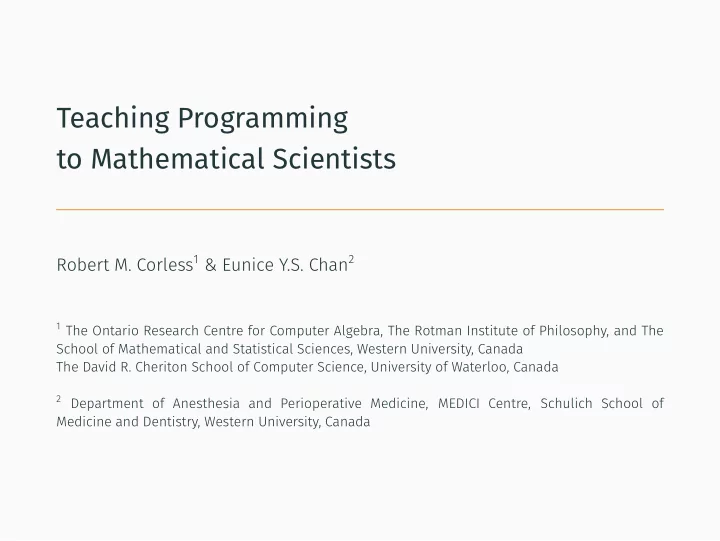

Teaching Programming to Mathematical Scientists School of Mathematical and Statistical Sciences, Western University, Canada The David R. Cheriton School of Computer Science, University of Waterloo, Canada Medicine and Dentistry, Western University, Canada Robert M. Corless 1 & Eunice Y.S. Chan 2 1 The Ontario Research Centre for Computer Algebra, The Rotman Institute of Philosophy, and The 2 Department of Anesthesia and Perioperative Medicine, MEDICI Centre, Schulich School of
We live in a rough world Figure 1: An infinite number of infinity symbols “The existence of these patterns [fractals] challenges us to study forms that Euclid leaves aside as being formless, to investigate the morphology of the amorphous.” (Benoit B. Mandelbrot, The Fractal Geometry of Nature , 1983, p. 1) 1
Context • Teaching Computational Mathematics is increasingly important • This is diffjcult because computational mathematics involves several things at once: mathematics, programming, complexity, and numerical stability, because of the compromises needed for effjciency. • Incorporating new things means removing old things because we have only finite time to teach, and the students are learning other things as well. • “A spoon-ful of sugar helps the medicine go down” 2 (Data Science, Visualization, Machine Learning, . . . )
Fractals are sweet Figure 2: A Bohemian Example : All eigenvalues computed numerically by Maple of all 4096 seven by seven skew-symmetric bidiagonal matrices with 3 entries from { 1 , i , 1 + i , 1 − i } . See bohemianmatrices.com
Pass the Parcel (avanzar el paquete) students we play the game of “pass the parcel”: given an initial • The receiving student computes the next number by student. • We go around the room until the iteration converges, or we get bored, or everyone has had a chance. 4 Newton’s iteration is z n + 1 = z n − F ( z n ) / F ′ ( z n ) . To explain this to function (e.g. F ( z ) = z 3 − 1). • One student chooses an initial number z 0 and passes it to the next. Here n = 0. z n + 1 = z n − F ( z n ) / F ′ ( z n ) and passes that result to the succeeding
Mandelbrot polynomials function [p,dp]=mandelpoly(z,k) % MANDELPOLY evaluates the k^th Mandelbrot polynomial % and its derivative at one or more points. % The k^th polynomial has degree 2^(k-1)-1 % Author PWL 2014.4.28 Modified RMC 2020.2.27 dp = zeros(size(z)); p for i=1:k-1 dp = p.^2+2*z.*p.*dp; p = z.*p.^2+1; end 5 = zeros(size(z));
6 The sixth iterate, p 6 ( x ) , for real x Figure 3: Graph of p 6 ( x ) and its derivative (blue) p ′ 6 ( x ) where p 0 ( x ) = 0 and p n + 1 ( x ) = xp 2 n ( x ) + 1.
Newton Fractals 7 Figure 4: Newton fractal of p 6 ( z ) (generated using Python)
Student-generated fractals Figure 5: Forty student-generated fractals 8
Challenges from IEEE floats • “Admit, for instance, the existence of a minimum magnitude, and you will find that the minimum which you have introduced, small as it is, causes the greatest truths of mathematics to totter.” — Aristotle • This (and other features) break students’ models of how the world works. • We have to enable students to deal with floats. 9 • Floats are not associative : a + ( b + c ) ̸ = ( a + b ) + c necessarily. For instance − M + ( M + 1 ) = 0 while ( − M + M ) + 1 = 1 if M = 3 . 14 · 10 17 .
Mathematical Notions Strengthened by Programming Several mathematical notions are strengthened by these exercises. • We use mathematical induction to prove correctness of the automatic difgerentiation of the Mandelbrot polynomials • The analysis of IEEE floats uses the IEEE guarantees • Practice with functions is always useful • Simply working with visualizations improves people’s feel for geometry. 10 (fl ( x op y ) = ( x op y )( 1 + δ ) for some | δ | ≤ u where u is the unit roundofg , 2 − 53 for double precision)
Reference Papers Chauvenet prize-winning papers 1. Wilkinson, James H. “The perfidious polynomial.” Studies in numerical analysis 24 (1984): 1-28. 2. Olds, C. D. “The simple continued fraction expansion of e .” The American Mathematical Monthly 77.9 (1970): 968-974. 3. Davis, Philip J. “Leonhard Euler’s integral: A historical profile of the Gamma function: In memoriam: Milton Abramowitz.” The American Mathematical Monthly 66.10 (1959): 849-869. 11
Reference Texts and Videos 1. Moler, Cleve B. Numerical Computing with MATLAB: Revised Reprint. Vol. 87. Siam, 2008. 2. Higham, Desmond J., and Nicholas J. Higham. MATLAB guide. Society for Industrial and Applied Mathematics, 2016. 3. MIT OpenCourseWare: Gil Strang and Cleve Moler 12
References • Chan, Eunice Y.S., and Robert M. Corless. ”A random walk through experimental mathematics.” arXiv preprint arXiv:1801.05423 (2018). (In press) • Corless, Robert M. ”Computer-mediated thinking.” Proceedings of Technology in Mathematics Education (2004). • Frame, Michael, and Benoit B. Mandelbrot. Fractals, graphics, and mathematics education. No. 58. Cambridge University Press, 2002. • Li, Ao, and Robert M. Corless. “Revisiting Gilbert Strang’s A chaotic search for i .” ACM Communications in Computer Algebra 53.1 (2019): 1-22. 13
Thank You ¡Time for Questions! 14
Recommend
More recommend